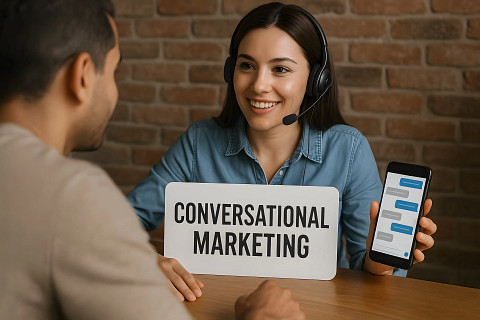Apple and Google recently rolled out updates in iOS26 and Android 16, pushing ahead a major shift in marketing. From altering visibility and delivery to a greater focus on control and experience, messaging has never been more exciting – or more challenging – for marketers.
These changes are reshaping how subscribers see, engage with and prioritize messages and notifications. The days of sending unpersonalized, batch-and-blast communication to a mass audience are officially over. The most effective marketers will use these changes as an opportunity to evolve their strategies across channels – email, SMS, mobile app – to create more meaningful relationships with customers.
Here’s a deeper look at the changes and steps you can take to adjust.
Turn mobile channels into a growth engine
Are you heading to San Francisco for Dreamforce? Check out this session on mobile marketing on October 15 or 16.



How AI is impacting marketing engagement
AI-generated Summaries and Previews in emails and text messages, originally introduced in iOS18, will now be the default in the Mail app. This is the biggest change to hit messaging since Gmail introduced tabs back in 2013.
Apple Intelligence automatically identifies and summarizes key points, including order tracking details, so a user no longer has to open a message to know what a company has to say. Gmail, Yahoo and Android have released similar capabilities with more smart features expected to come.
Historically, image-only emails have caused a negative impact on deliverability, accessibility and even performance. Now a lack of HTML text in an email could lead to inaccurate summaries and a poor subscriber experience.
Priority Messages and Notifications will selectively surface messages or alerts deemed important or time-sensitive. Messages without clear urgency or relevance will risk being deprioritized and reducing overall engagement.
It’s important to keep in mind how the complexity of your content, nuances in language or contextual understanding can influence how AI accurately summarizes, or even suppresses, your messages across channels.
4 tips for high-performing messages
- Get to the point in the first 20 characters of your subject line and message copy. Vague, click-bait subject lines and generic blasts will no longer work.
- Lead with value. In email, use descriptive HTML text and bullet points for key messages and place CTAs higher in the body. In SMS, provide recognizable sender information and concise, high-value offers or updates.
- Subscriber behavior is changing. As open rates and read alerts become less reliable, engagement measurement must shift toward conversions, replies and downstream actions.
- Use Inbox Monster in Marketing Cloud to preview and test your layout, copy and design across devices to ensure it is optimized for both humans and AI. This is key to delivering the best possible experience to your subscribers.
How to navigate user control and privacy
Changes to Apple’s Messages app provides iPhone users with even more control to text messaging. Screen Unknown Senders will reduce the number of unwanted text messages by routing messages from numbers not saved in a contact list into a separate, dedicated folder. There is a built-in safeguard for time-sensitive notifications, such as two-factor authentication (2FA) codes. These alerts will temporarily appear, even if they come from a number not saved in a contact list.
Apple is also enhancing Link Tracking Protection, which automatically removes tracking parameters from URLs shared in Safari, Mail and Messages. Traditional methods of click-based attribution become more difficult because the identifiers that are needed to track will be removed.
Many email clients have rolled out capabilities like Gmail’s Manage Subscriptions, where users can easily view and manage subscriptions directly in their inbox. Mailbox providers are showing their users just how much mail they are getting from senders. Providing users the ability to decide what messages they want to see could lead to elevated unsubscribe rates. These shifts mean subscribers have more control than ever over which brands earn inbox visibility.
This is all a wakeup call for brands to review their opt-in process across channels and ensure they get explicit permission to communicate with their subscribers. And once they have it, the should prioritize sending personalized, recognizable high-quality content.
5 tips for better visibility:
- Drive more relevant and meaningful engagement through agentic, two-way conversations.
- Encourage contact saving, tap-to-join links, and QR opt-ins during your first message, so future texts bypass the Unknown Senders folder.
- Enhance segmentation and fuel personalization with Data Cloud by using purchase history, engagement level and preferences.
- Focus on quality over quantity. Send targeted, wanted messages when you have something to say. For email, Einstein Engagement Frequency in Marketing Cloud can help with this.
- Shift to Server-Side Campaigns and privacy-aligned attribution methods to connect your marketing messages to conversions without relying on stripped URL parameters.
Watch Dreamforce from home
Can’t make it to the Bay Area? No worries. You can stream the action for free on Salesforce+ throughout the three days.



What to know about new notifications features
Android is introducing more improvements to usability and organization for app notifications. For example, Notification Organizer is an AI-powered system that automatically sorts notifications into categories like News, Promotions, Social, and Suggested. In addition, long-pressing a notification now presents two options: “Dismiss” and “Turn off.”
The Live Updates feature is designed to provide prominent, real-time progress tracking for time-sensitive activities, such as ride-shares, food delivery, and active navigation. These updates appear expanded on the lock screen for easy, at-a-glance access, so users don’t miss critical updates. Apple has similar functionality, Live Activities.
Notification Auto-Grouping bundles multiple notifications from an app into a single alert, and Notification Cooldown lowers the volume and visibility of repetitive notifications from the same app to prevent alert overload. If the phone detects a high number of alerts from a single app, it will lower the sound and minimize new pop-up alerts for a period of up to two minutes.
Apple has some intelligent enhancements coming to Focus Mode. Users can select Reduce Interruptions, which engages Intelligent Breakthrough and Silencing. This will automatically determine the importance of a notification in real time. When enabled, it allows important notifications (such as those from your family) to break through, while silencing less-urgent alerts.
Not all messages are treated equally anymore. These changes emphasize the importance of messaging usefulness and relevancy, in order to maintain brand visibility.
4 tips for making sure your notifications do their job
- Ensure your notifications and alerts are always clear, recognizable and valuable. With Marketing Cloud’s Mobile App Messaging, our unified Software Development Kit (SDK) is always maintained with built-in best practices.
- Rethink the frequency of your sends or risk being muted, minimized or even unsubscribed.
- Consider adding in-app messaging for communication, since it’s unaffected by device-level filters. Save your SMS and push notifications for truly time-sensitive, high-value updates.
- Orchestrate campaigns across channels and departments with Journey Builder and Salesforce Flow in Marketing Cloud.
Related content
How to understand compliance and quiet hours
Marketers are likely familiar with the consumer protections from the Federal Communications Commission (FCC)‘s Telephone Consumer Protection Act (TCPA). Now several states, including Florida and Texas, are rolling out mini-TCPA laws with varying restrictions.
These state-level regulations expand the scope of TCPA to include text messages and impose more restrictive communication “quiet windows”. Consumers can revoke their consent to receive text messages “at any time and through any reasonable means”.
States and regions may have different consent requirements, time-of-day restrictions, and message frequency recommendations. But if companies do not honor the guidance set, it can lead to penalties and/or fines. Consult your legal team for the most up-to-date guidance on local regulations.
5 tips for compliance:
- Use Send Blockouts in Marketing Cloud (SMS and Push) to prevent messages from being delivered during specified time periods.
- Maintain a real-time record of explicit opt-ins across all channels. Automated logging ensures regulatory compliance.
- Recognize and act quickly on opt-out requests, whether via unsubscribe links, opt-out keywords or notification preferences.
- Adjust messaging frequency and content to align with cultural norms and operating system changes.
- Consider segmenting users by engagement behavior. Highly engaged subscribers may tolerate more frequent messaging.
How to succeed in the new messaging landscape
Marketers need to expect evolving changes to marketing engagement. These recent device updates heavily focus on providing more control to your users. Marketers should understand how to adapt their campaign strategies to ensure delivery, relevancy and legal compliance.
There will likely be more tweaks in the months ahead (don’t worry, we’ll keep you posted!). The bottom line is that success in today’s landscape requires awareness and adaptability, regardless of what type of message is sent. Stay informed and flexible, and you’ll be in great shape.
Make your customer interactions a two-way conversation
Learn how Marketing Cloud brings autonomous AI agents, actionable data, and full-funnel workflows together for truly connected engagement.

































